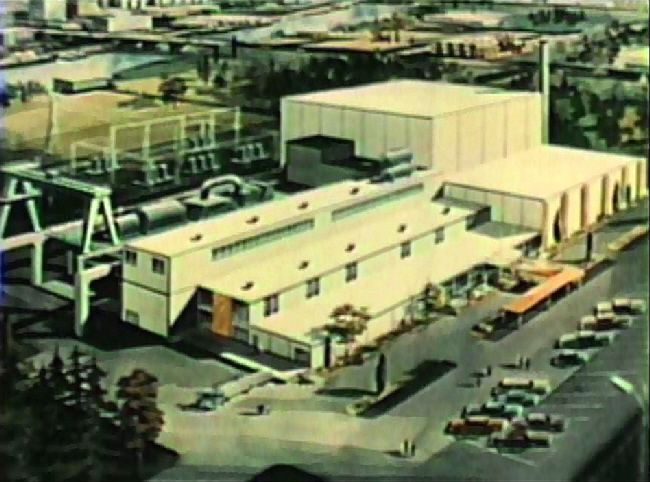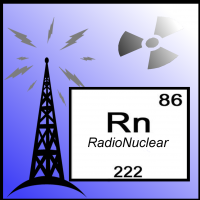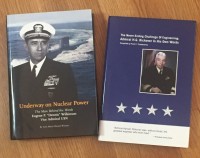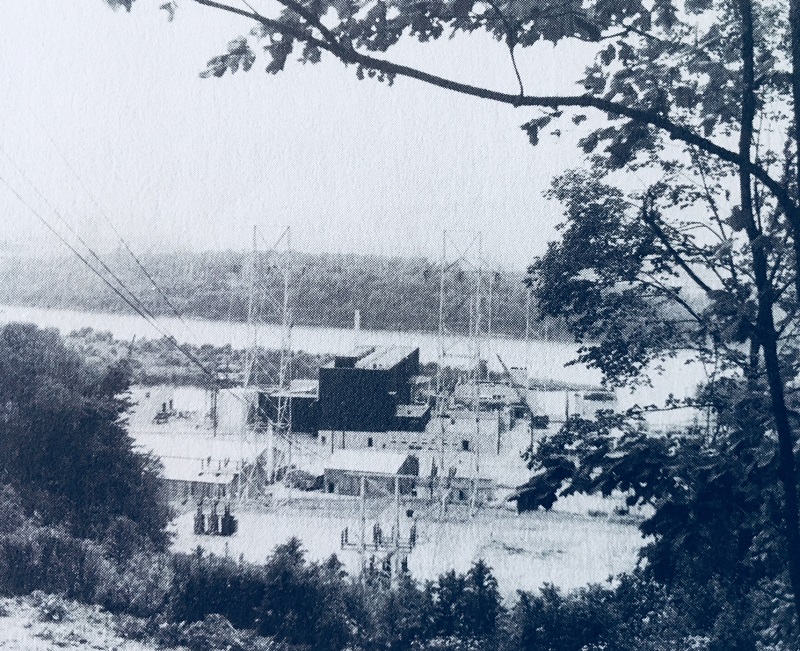Honoring Dr. Leona Woods - #Herstory
During March's Women's History Month, I honor Leona Woods by telling #herstory.
The ANS Nuclear Cafe is a blog owned and edited by the American Nuclear Society. Information contained on the ANS Nuclear Cafe has been provided by numerous sources. Therefore, the American Nuclear Society assumes no responsibility or liability for the accuracy of information contained herein. DISCLAIMER: The views expressed in posted articles do not necessarily reflect the views of the American Nuclear Society. The views expressed here are those of the individual authors. ANS takes no ownership of their views. The American Nuclear Society assumes no responsibility or liability for any use or operation of any methods, products, instructions, or ideas contained on this site.

A message from Electrical Builders, Ind.
America’s Top Performing Nuclear Plants Rely on Electrical Builders, Industries to Expand and Extend the Life of Their Critical Electrical Assets
During March's Women's History Month, I honor Leona Woods by telling #herstory.
Welcome back for another great episode of RadioNuclear! Today, I am happy to announce that RadioNuclear is now sponsored by the American Nuclear Society, in the hopes to bring you even more of the podcast you know and love! In this episode, we cover a range of news topics, including how anti-nuclear policy and perception are hurting the nuclear industry in the U.S. and South Korea. We also cover INL's 70th year of operation, and talk about a great advocacy toolkit from the Department of Energy, the Ultimate Fast Facts Guide to Nuclear Energy.

Early 1960's artist's concept for a commercial organic cooled nuclear power plant - right near a city. This isn't far from what actually happened as we'll see below. Concept art published by Atomics International.
The present re-examination of reactor principles tried in the past but for one or another reason sidelined has skipped a very significant principle: Organic coolant. This was an early idea which received a great deal of research and press during the great buildup of nuclear technology; today, it's largely been forgotten. Let's take another look!
Idaho National Laboratory is celebrating 70 years of operation in the mission of advancing knowledge in the field of nuclear technology. Materials, methods - even basic questions about feasibility of certain concepts - have been tested and proven at this historic, and quite large remote facility in the Idaho desert over all these years. A number of notable firsts have occurred there, including the first operation of a nuclear plant designed for shipboard use (STR, later S1W) as well as tests for the (abortive) nuclear bomber program. Thousands of valuable test hours were racked up by samples in the legendary Materials Test Reactor and its neighbor the Engineering Test Reactor - both now gone, their former sites mostly now a parking lot.
As I write this, I'm excited to know the future of the American Nuclear Society will involve the activities and efforts of the newly formed Diversity and Inclusion in ANS (DIA) Committee. The DIA Committee was formed after the 2018 Annual Meeting by expanding the Professional Women in ANS (PWANS) committee with the inclusion of Nuclear Pride, a LGBTQA+ nuclear organization. It is dedicated to giving a voice to all underrepresented and marginalized groups within ANS, including, but not limited to, women, persons of color, the LGBTQA+ community, and people with disabilities. This new committee is the result of the combined efforts of several people over several years to ensure all of these groups, named and not named, have a voice.
 Founded by the National Society of Professional Engineers in 1951, Engineers Week (EWeek), is dedicated to ensuring a diverse and well-educated future engineering workforce by increasing interest in engineering and technology careers. This year, consider bringing an engineer into your plans.
Founded by the National Society of Professional Engineers in 1951, Engineers Week (EWeek), is dedicated to ensuring a diverse and well-educated future engineering workforce by increasing interest in engineering and technology careers. This year, consider bringing an engineer into your plans.
It was released this week that the US Army Corps of Engineers has decided to enter into the process of decontaminating and dismantling the historic SM-1 nuclear plant at Fort Belvoir, Virginia. This early military prototype plant isn't often discussed or even remembered today, so let's look at the history of this project through photos.
Nuclear energy has played a key supporting role in historic missions to Mars, Pluto, and across the Solar System for the last 50 years. On January 1 2019, the nuclear-powered New Horizons flew by the most distant object ever observed up close - Ultima Thule, after it having already flown by Pluto in 2015.
 Welcome to the New Year! Even though I am on the road, there is just so much happening lately in nuclear I could not pass up the opportunity to talk about it! This episode of RadioNuclear, we take a look at recent and exciting legislation and policy for advanced nuclear. This includes the passages of the NEIMA and NEICA bills and what the Idaho National Laboratory may look like in the coming years. We also discuss the NRC's recent decision on post Fukushima regulation. Lastly, we look on how you can adopt a dog from the Chernobyl exclusion zone. No, I am not making that up!
Welcome to the New Year! Even though I am on the road, there is just so much happening lately in nuclear I could not pass up the opportunity to talk about it! This episode of RadioNuclear, we take a look at recent and exciting legislation and policy for advanced nuclear. This includes the passages of the NEIMA and NEICA bills and what the Idaho National Laboratory may look like in the coming years. We also discuss the NRC's recent decision on post Fukushima regulation. Lastly, we look on how you can adopt a dog from the Chernobyl exclusion zone. No, I am not making that up!
Two bipartisan pieces of legislation modernizing America's nuclear future have recently become law. It's still a long way from pushing nuclear builds the way we need to address a host of environmental issues, but it is a good start.
At the end of last month there was some press about the emissions from cargo ships as a threat to the environment, and in due course nuclear propulsion was brought up as a way to get around it. It seems that every once in a while nuclear propulsion for cargo and/or passenger ships is revived, only to be forgotten again after a few superficial studies. The plain fact seems to be that the economics of nuclear ships will not allow their wide spread until something external re-racks the whole economic model of shipping to allow this option to be considered. That "something" is very likely to be penalty for emissions near shore, or for burning fossil fuel in ships in the first place - in other words, some form or another of carbon taxing applied specifically to open-ocean shipping.
This article is the fifth in a continuing series examining the delays in nuclear plant construction and increases in nuclear plant overall (project) cost during the large round of construction in the United States. Previous installments are linked at the end of this article.
Welcome to 2019! I hope everyone who took a break enjoyed it. For those who didn't, why didn't you? Initially, I had thoughts of trying to separate from social media and news to a significant extent during the holidays but, after conversations with Linda Zec (our wonderful ANS staff liaison for the Social Media Team, among many other things) decided that it was impractical to do so for a variety of reasons. So, as the holiday furor ebbed and flowed and I continued, still connected, to read news and year-end summations, I found myself wishing that there wouldn't be so much frustrating news in 2019. That's why I decided to open my eighth calendar year writing for the ANS Nuclear Cafe with a wish list, or "listicle" in the inside jargon, if you prefer. Here, in ascending order of importance (or, I suppose, increasing order of unlikelihood) are my five wishes for this new year in nuclear energy. (All on one screen; no annoying "next" buttons. You're welcome.)
The accident that occurred at Three Mile Island on March 28, 1979, brought about many changes to the nuclear industry. Among the changes was the industry stopping to reflect on current procedures and the training of its employees. Exhorted by the findings of the Kemeny Commission and sponsored by the Department of Energy, industry leaders and training personnel began meeting on improvements to training at the Gatlinburg Conference in the early 1980's.
 RadioNuclear host Doug Hardtmayer interviews ANS member Dr. Christopher Morrison, an Astro-Nuclear Engineer with Ultra Safe Nuclear Corporation. Dr. Morrison shares his story as well as some fascinating insights into how nuclear could shape the future of nuclear in space!
RadioNuclear host Doug Hardtmayer interviews ANS member Dr. Christopher Morrison, an Astro-Nuclear Engineer with Ultra Safe Nuclear Corporation. Dr. Morrison shares his story as well as some fascinating insights into how nuclear could shape the future of nuclear in space!
December 20, 1951 marks an important date in the history of nuclear power; it's the date on which the first useful electric power was generated by atomic fission. While the now-famous event at that time only powered four light bulbs, the somewhat stunt-like nature of the day obscured the fact that the plant was actually set up to generate considerably more power, and did so. Let's take a look at this fact and, at the same time, the facility through illustrations from my collection and from photographs that I took myself while touring EBR-1 earlier this year.
 I was honored to participate in a panel session on November 14, 2018, at the American Nuclear Society's Winter Meeting in Orlando, Florida. The title of the session was "Underway on Nuclear Power: A Retrospective," focusing on the importance to nuclear power of Admiral Hyman G. Rickover and Vice Admiral Eugene P. "Dennis" Wilkinson.
I was honored to participate in a panel session on November 14, 2018, at the American Nuclear Society's Winter Meeting in Orlando, Florida. The title of the session was "Underway on Nuclear Power: A Retrospective," focusing on the importance to nuclear power of Admiral Hyman G. Rickover and Vice Admiral Eugene P. "Dennis" Wilkinson.

Shippingport Atomic Power Station as pictured in original press package; photo PR-19109
December 1957 would prove to be a month of firsts for the Shippingport Atomic Power Station; the plant had only recently been completed, and its new and novel reactor had only just achieved its first criticality on December 2nd. These were pioneering days, though - after all, the plant project had only been authorized in July 1953, some four and a half years earlier, give or take. Groundbreaking for the plant, after a selection process to decide who would partner with the Atomic Energy Commission (AEC) in the project happened on land provided by Duquesne Light Company in September 1954 with real construction work starting in March, 1955. Thus, the plant had been constructed in about two and a half years. In that spirit, operating the plant to see what it could do wouldn't wait for a battery of tests.
 ANS member Dr. Christopher Morrison was a recent guest on The Space Show. Dr. Morrison covered space radiation, lifetime radiation limitations, legal limits, rodent GCR and radiation experimentation, terrestrial radiation simulations, space nuclear power & propulsion, super-cooling conductivity.
ANS member Dr. Christopher Morrison was a recent guest on The Space Show. Dr. Morrison covered space radiation, lifetime radiation limitations, legal limits, rodent GCR and radiation experimentation, terrestrial radiation simulations, space nuclear power & propulsion, super-cooling conductivity.